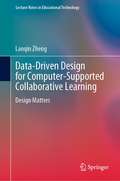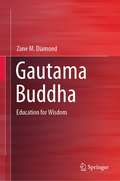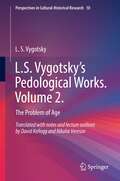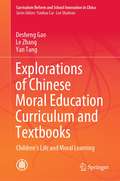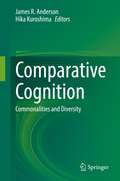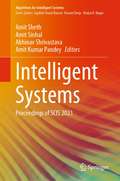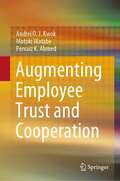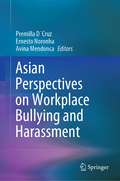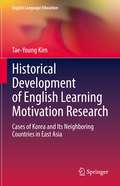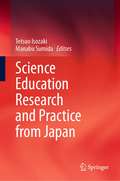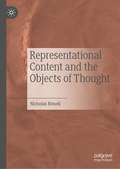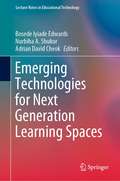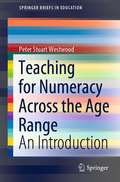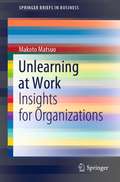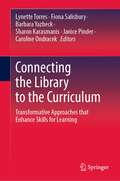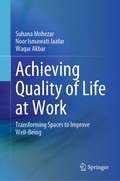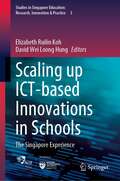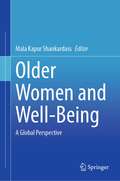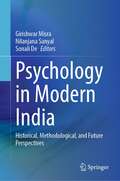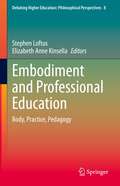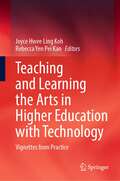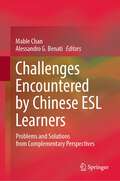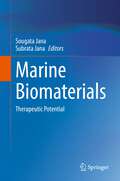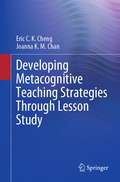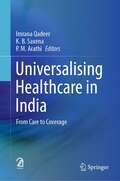- Table View
- List View
Data-Driven Design for Computer-Supported Collaborative Learning: Design Matters (Lecture Notes in Educational Technology)
by Lanqin ZhengThis book highlights the importance of design in computer-supported collaborative learning (CSCL) by proposing data-driven design and assessment. It addresses data-driven design, which focuses on the processing of data and on improving design quality based on analysis results, in three main sections. The first section explains how to design collaborative learning activities based on data-driven design approaches, while the second shares illustrative examples of computer-supported collaborative learning activities. In turn, the third and last section demonstrates how to evaluate design quality and the fidelity of enactment based on design-centered research.The book features several examples of innovative data-driven design approaches to optimizing collaborative learning activities; highlights innovative CSCL activities in authentic learning environments; demonstrates how learning analytics can be used to optimize CSCL design; and discusses the design-centered research approach to evaluating the alignment between design and enactment in CSCL. Given its scope, it will be of interest to a broad readership including researchers, educators, practitioners, and students in the field of collaborative learning, as well as the rapidly growing community of people who are interested in optimizing learning performance with CSCL.
Gautama Buddha: Education for Wisdom
by Zane M. DiamondThis book examines some of the key elements of Buddhist education theory, in particular about educating for wisdom, the ultimate goal of Buddhist education. The teachings of Gautama Buddha have endured for thousands of years carried into the present era in schools, universities, temples, personal development courses, martial arts academies and an array of Buddhist philosophical societies across the globe. Philosophically, the ideas of the Buddha have held appeal across many cultures, but less is known about the underlying educational theories and practices that shape teaching and learning within Buddhist-inspired educational contexts. The chapters outline the development of the Buddha’s teachings, his broad approach to education and their relevance in the 21st century. Subsequently, the book reviews the history of the evolution of the various schools of Buddhist thought, their teaching and learning styles and the dissemination among Asia and later also the Western countries. The book discusses education theories and devices embedded within the Buddhist teachings, examining the works found in the Tipitaka, the Buddhist canon.
L.S. Vygotsky’s Pedological Works. Volume 2.: The Problem of Age (Perspectives in Cultural-Historical Research #10)
by L.S. VygotskyThis book is the second volume in a series presenting new English translations of L.S. Vygotsky’s writings on the holistic science of the child he called “pedology”. It presents unique materials which reflect the development of Vygotsky’s theoretical position at the last stage of his creative evolution in 1932-1934 and contributes to the number of original Vygotsky texts available in English. It includes the problem of age and age periodization; the structure and dynamics of age, psychological characteristics of age crises and diagnostics of development in relation to age, and the zone of proximal development, which became his most widely known but least understood theoretical innovation. This book places that concept in its context and makes it fully understandable for the first time. In addition, there are lectures and notes that Vygotsky made in preparation for lectures on six critical periods: birth, one year old, three, seven, and thirteen. Vygotsky also devotes chapters to the stable periods of infancy and early childhood and two whole chapters to school age. Future volumes in this series will explore Vygotsky’s pedology of the adolescent.
Explorations of Chinese Moral Education Curriculum and Textbooks: Children’s Life and Moral Learning (Curriculum Reform and School Innovation in China)
by Le Zhang Yan Tang Desheng GaoThis book shares with English readers Chinese theoretical and practical explorations of moral education curriculum for primary schools within the basic education curriculum reform project since 2001.The book expounds this moral education curriculum reform and focuses on three main ideas: The curriculum’s aim is to enrich children’s experiences and reflect their own lives; the curriculum’s content is originated from children’s lives; the curriculum’s structure is developed from children’s learning approach in their morality and social study. In this book, light is also shed on how to construct moral education textbooks, direct moral instruction, and moral teacher identity in the perspective of moral learning; how to knit law education and Chinese traditional culture education in moral curriculum.This is the first comprehensive book focusing on Chinese moral education curriculum reform. It will appeal to researchers, research students, and writers of moral education textbooks. It is also suitable for teacher training programs to help future teachers learn about moral education curriculum and help them effectively design and organize it for children’s morality study.
Comparative Cognition: Commonalities and Diversity
by James R. Anderson Hika KuroshimaThis book presents an overview of selected topics in comparative cognition, which is the study of behaviour and mental activities in nonhuman animals. Human psychological capacities are often used as a heuristic by comparative cognitive scientists, whose tasks include designing valid procedures for studying species’ sensory, linguistic or manipulatory abilities that differ from those of humans. Nonetheless, researchers have developed many original ways to gain insights into how other species perceive the world, store and integrate information, and communicate. The contributors to this book have all been involved in such work, and will present some of the approaches that have led to clear advances in our understanding of cognitive processes in other species. The chapters integrate a review of past literature with recent work, covering a variety of subject species including birds, domestic dogs and cats, and nonhuman primates. All contributors have worked with or been otherwise influenced by Professor Kazuo Fujita, to whom the volume will be dedicated. Fujita’s openness to research on various topics and species is reflected in the diversity of the chapters presented.The book will be of interest to students and more experienced researchers in diverse fields including psychology, anthropology, biology and veterinary studies.
Intelligent Systems: Proceedings of SCIS 2021 (Algorithms for Intelligent Systems)
by Amit Sheth Amit Sinhal Abhinav Shrivastava Amit Kumar PandeyThis book contains the latest computational intelligence methodologies and applications. This book is a collection of selected papers presented at International Conference on Sustainable Computing and Intelligent Systems (SCIS 2021), held in Jaipur, India, during February 5–6, 2021. It includes novel and innovative work from experts, practitioners, scientists, and decision-makers from academia and industry. It covers selected papers in the area of artificial intelligence and intelligent systems, intelligent business systems, machine intelligence, computer vision, Web intelligence, big data analytics, swarm intelligence, and related topics.
Augmenting Employee Trust and Cooperation
by Pervaiz K. Ahmed Andrei O. Kwok Motoki WatabeThis book is an essential guide for academics and practitioners to understand employees’ differences in personality and how best to motivate them accordingly. The authors provide an in-depth perspective of how organizations can better prepare for the new realities of the workplace. Amidst the war for talent and a continually evolving workplace that has reduced employee psychological attachment, employees prefer to be treated as individuals with the expectation of individual recognition and reward. The authors draw from their personal, corporate, and research experience by combining interdisciplinary perspectives (organizational behavior, human resource management, psychology, sociology, economics) to offer holistic insights into individual expectancy and motivation integral to a successful employer-employee interaction.Interestingly, research remains lacking on the effects of excessive extrinsic rewards on trust and cooperation. Hence, this book fulfills significant gaps in vital areas that existing studies have not yet sufficiently addressed. These areas are psychological contract, excessive extrinsic rewards, and individual differences in personality (locus of control and general trust). The authors use scenario-based laboratory experiments to examine the moderating effects of locus of control and general trust that underscore employee expectations. The differential effects contribute to insight on behavioral outcomes in the workplace that result from employee perception, personality, and intention towards the provision of rewards.Consequently, the book dispels the discrepancies between economists and psychologists about the efficacy of rewards. Findings demonstrate that although excessive extrinsic rewards augment all employees’ trust and cooperation, it is vital for employers to reward selectively those who are most deserving. Findings offer a deeper understanding of the saliency, efficacy, and judiciousness of excessive extrinsic rewards. Employers will benefit by understanding how best to tailor rewards to motivate each employee.
Asian Perspectives on Workplace Bullying and Harassment
by Premilla D’Cruz Ernesto Noronha Avina MendoncaThis book showcases empirical studies on workplace bullying from a range of Asian countries, including China, India, Indonesia, Israel, Japan, Jordan, Malaysia, Pakistan, Singapore, South Korea, Sri Lanka, Thailand, UAE and Vietnam, and is the first-of-its-kind single academic project documenting workplace emotional abuse in the world’s largest continent. It encompasses the ‘varieties of workplace bullying’ conceptualization in addition to category-based harassment and abusive supervision, and presents target, bystander and interventionist perspectives, along with contextualized insights into the phenomenon. The book speaks to the significance of sociocultural factors and draws on several theoretical and substantive bases including dignity, social cynicism, coping, gender, sexual orientation, job insecurity, turnover intention, affective events theory, attribution theory, regulation and policy initiatives. Covering all major regions in Asia where workplace bullying has been found to occur, namely West Asia, South Asia, Southeast Asia and East Asia, the book portrays studies which engage both positivist and postpositivist paradigms, utilize an array of methods and include a range of industrial sectors and employment contracts and all levels of the organization. While focused on Asia, the book’s insights have international relevance and are of interest to the worldwide community of researchers, practitioners and students of organizational studies, human resource management, industrial sociology, work psychology, industrial relations, labour law, corporate law, health sciences, social work and Asian studies.
Historical Development of English Learning Motivation Research: Cases of Korea and Its Neighboring Countries in East Asia (English Language Education #21)
by Tae-Young KimThis book clarifies the fundamental difference between North America-based instrumental motivation and Korea (and East Asia)-specific competitive motivation by which the EFL learners’ excessive competition to be admitted to famous universities and to be hired at a large-scale conglomerate is the main source of L2 motivation. It enables readers to understand that EFL-learning motivation reflects unique sociohistorical contexts grounded in a specific region or country. This book in turn necessitates the need to develop EFL motivation theory and research tradition which are firmly based on East Asian values and culture.
Science Education Research and Practice from Japan
by Tetsuo Isozaki Manabu SumidaThis book project poses a major challenge to Japanese science education researchers in order to disseminate research findings on and to work towards maintaining the strength and nature of Japanese science education. It also presents a unique opportunity to initiate change and/or develop science education research in Japan. It provides some historical reasons essential to Japanese students’ success in international science tests such as TIMSS and PISA. Also, it helps to tap the potential of younger generation of science education researchers by introducing them to methods and designs in the research practice.
Representational Content and the Objects of Thought
by Nicholas RimellThis book defends a novel view of mental representation—of how, as thinkers, we represent the world as being. The book serves as a response to two problems in the philosophy of mind. One is the problem of first-personal, or egocentric, belief: how can we have truly first personal beliefs—beliefs in which we think about ourselves as ourselves—given that beliefs are supposed to be attitudes towards propositions and that propositions are supposed to have their truth values independent of a perspective? The other problem is how we can think about nonexistents (e.g., Santa Claus) given the widespread view that thought essentially involves a relation between a thinker and whatever is being thought about. The standard responses to this puzzle are either to deny that thought is essentially relational or to insist that it is possible to stand in relations to nonexistents. This book offers an error theory to the problem. The responses from this book arise from the same commitment: a commitment to treating talk of propositions—as the things towards which our beliefs are attitudes—as talk of entities that actually exist and that play a constitutive and explanatory role in the activity of thought.
Emerging Technologies for Next Generation Learning Spaces (Lecture Notes in Educational Technology)
by Bosede Iyiade Edwards Nurbiha A. Shukor Adrian David CheokThis book discusses the development of the next generation learning spaces with emerging technologies. These spaces result from the combined needs of classroom stakeholders, such as instructors and learners, with classroom elements, such as tools and technologies, pedagogy and content. The book presents discussions and studies on issues, possibilities and implications of these changes for next generation education. Novel ideas, and studies on these all-encompassing, blended roles of technologies in next generation learning spaces are clearly presented. Suggestions on how the benefits they offer can be maximized are also discussed. Engaging learning technologies have remained central in education for assisting instructors to teach and learners to learn, more effectively. However, recent technological growth is creating a system in which previous divides between key classroom concepts and stakeholders are getting progressively blurred. This is giving rise to next generation learning spaces where elements and stakeholders are blended into one. The book addresses the future of learning environments based on these perspectives.
Teaching for Numeracy Across the Age Range: An Introduction (SpringerBriefs in Education)
by Peter Stuart WestwoodThis book provides an introduction to what it means to be numerate, and how numeracy can best be developed and nurtured in children and in adults. It also presents a cohesive coverage of numeracy development from early childhood to adulthood. This book draws on international research and practice to provide a comprehensive overview on the topic. It depicts and draws connections with the National Curriculum in the United Kingdom, the Australian Curriculum, and the Common Core State Standards in the United States. This book identifies skills and concepts involved in achieving functional numeracy, and provides practical advice on effective teaching, learning and assessment. It serves as a valuable guide to educators who teach mathematics in primary and secondary schools, but who are not specifically trained in the subject.
Unlearning at Work: Insights for Organizations (SpringerBriefs in Business)
by Makoto MatsuoThis book is to provide insights into the process of individual unlearning, which is little known in previous studies. This is the first book that described how employees should unlearn, i.e., abandon obsolete and outdated beliefs or routines to acquire new ones, at workplace. Updating old knowledge and skills to new one is crucial not only for organizations but also for individuals to survive in today’s competitive and turbulent environment. It provides readers with mechanisms by which personal factors, such as goal orientation, reflection, and critical reflection, and promotes employees’ unlearning under the influence of situational factors such as supervisors’ behaviors and promotion of the positions. Based on the findings by quantitative and qualitative analyses using questionnaire survey and interviews, this book is highly recommended to readers who are interested in higher-order learning process for self-change at work in the fields of organizational behavior and human resources development.
Connecting the Library to the Curriculum: Transformative Approaches that Enhance Skills for Learning
by Lynette Torres Fiona Salisbury Barbara Yazbeck Sharon Karasmanis Janice Pinder Caroline OndracekThis book shares the experiences of the Monash University and La Trobe University libraries in Melbourne, Australia, regarding the paths taken to transform and reposition these libraries within their institutions. The book showcases the respective frameworks used to enhance library skill development programs and addresses central topics such as partnerships, pedagogy, curriculum, emerging skill agendas and student success. It offers a theoretical and practical approach to overcoming persistent challenges and discusses several pertinent areas, e.g., establishing library-faculty partnerships, explicitly and coherently developing students’ research skills with discipline-specific content and transforming perceptions of academic libraries’ educative role. The book highlights the current issue of enhancing students’ research skills, which is forcing many academic libraries to reassess their established practices and adopt pedagogical approaches that will more readily resonate with faculty.Chapters 3 and 19 are available open access under a Creative Commons Attribution 4.0 International License via link.springer.com.
Achieving Quality of Life at Work: Transforming Spaces to Improve Well-Being
by Suhana Mohezar Noor Ismawati Jaafar Waqar AkbarThis book provides an understanding and imaging of how a stress-free workplace might be designed and implemented in the context of the ‘new normal.’ Statistics show that more and more people are experiencing an increase in work-related stress, and its impact on individual psychology and well-being as well as organizational performance can be devastating. Globally, the most recent data on work-related illnesses account for 2.4 million deaths. Against this backdrop, and taking stock of how the pandemic is affecting the workplace and employee well-being, this book proposes transformations in work spaces, from implementing effective “greening” features, to more efficient technology-supported spaces. It establishes links between workplace design and creativity, happiness and productivity, confronting related issues such as generation gaps, digital interruptions, collaborative work environments and sustainability, and their respective connections with workspace environment and well-being. The book situates this discussion within a broader discussion on work and quality of life. Furthermore, the book demonstrates how several sustainable development goals might be achieved through transformed work spaces. Through an intersection between organizational psychology, well-being and quality of life studies, sociology, human resources, and ergonomics, this book is a timely examination of work-related stress in relation to work spaces that require rethinking and transformation in the throes, and wake, of the pandemic.
Scaling up ICT-based Innovations in Schools: The Singapore Experience (Studies in Singapore Education: Research, Innovation & Practice #3)
by Elizabeth Ruilin Koh David Wei Loong HungThis collected book is about the eduLab projects, an initiative with focus on Scaling Change through Apprenticising and Ecological Leadership, designed to surface and spread ground-up information and communication technology-based pedagogical innovations. It presents the goals and rationale behind eduLab, an overview of the research projects conducted by its principal investigators during its funding tenure, as well as synthesizing thoughts on the entire endeavor. This book not only marks the achievements of the eduLab programme but also serves as inspiration for future projects. It presents Singapore education in action – a continually evolving and adapting education system that delivers a system well known for its high quality as much as it is forward-looking.
Older Women and Well-Being: A Global Perspective
by Mala Kapur ShankardassThis book provides deep insights into concerns related to the well-being in older women across the globe. Written by experts in the field, it explores social roles, health, quality of life/well-being, as well as concerns related to abuse and neglect, impacting the health of older women. It discusses important conditions for the holistic health of older women from different perspectives and provides practical guidelines towards improving the overall status of older women's well-being in society. The chapters analyze the wider implications of older women’s experiences as family members, drivers of economies and members of a diverse population worldwide. Covering a focus which is applicable to countries across continents, whether developed or developing, the book has an overall appeal to academicians, health care, policy makers as well as researchers in areas such as aging, gerontology, social work and psychology.
Psychology in Modern India: Historical, Methodological, and Future Perspectives
by Girishwar Misra Nilanjana Sanyal Sonali DeThis book offers a critical account of the conceptual, theoretical, and methodological developments in key areas of psychology in India, providing insights into the developments and advances as well as future directions. Filling an important gap in the literature on the history of psychology in India, it brings together contributions by leading scholars to present a clear overview of the state of the art of the field. The thematic parts of the book discuss the historical perspectives: development of psychology in India; research methodologies in the West and India; future directions for research in the field. The book is of special interest to researchers, school administrators, curriculum designers, and policymakers.
Embodiment and Professional Education: Body, Practice, Pedagogy (Debating Higher Education: Philosophical Perspectives #8)
by Stephen Loftus Elizabeth Anne KinsellaThis book draws attention to the ways in which an awareness of, and sensitivity to, embodiment can enlighten educational practices. It explores discourses from a range of thinkers, including Merleau-Ponty, Gadamer, Bakhtin, Haraway and Ahmed to name a few. The book argues that attention to embodiment can help us to reimagine the goals of education in ways that fit more coherently with human concerns and that offer the chance to provide education that is more holistic and grounded in our corporeality. Theories of embodiment can be used to modify education at the level of curriculum and at the level of pedagogy. This can help us design educational interventions that fit more naturally with how humans are inclined to learn and thus make educational experiences more meaningful. Attention to embodiment allows us to appreciate the extent to which the body appropriates a professional practice and the extent to which a professional practice appropriates the body of the learner. It shows how greater sensitivity to the body can enliven and enlighten our educational practices, especially in professional education.
Teaching and Learning the Arts in Higher Education with Technology: Vignettes from Practice
by Joyce Hwee Ling Koh Rebecca Yen Pei KanThis book is an inquiry about the possibilities of using technology to support the education of artists within higher education contexts. Even though technology-enhanced learning and teaching may seem incongruent with the long-established studio-based cultures of making and performing, it is increasingly becoming a pivotal point to connect artistes to potential audience and markets. Amidst the COVID-19 pandemic, technology is also the crucial linchpin for educational continuity of student artists. This book explores how technology could enhance the education of artists and designers as they continue to create, make, and add value to life and society through their artistry. It draws upon the experiences of the Nanyang Academy of Fine Arts (NAFA), a pioneering arts institution in Singapore with over 80 years of institutional history. Through 9 vignettes, this book illustrates technology-enhanced pedagogical practices that have been implemented in different artistic learning spaces including classroom, studio, and stage as well as institutional support strategies. With a naturalistic stance, these chapters seek to illuminate realistic pictures of teaching and learning that are being uncovered by artist educators as they sought to integrate technology within teaching practices using available technologies and within the classes that they are teaching. It is hoped that this book will stimulate conversation among artist educators about possible pedagogical models, as well as inform higher arts institutions about the contextual strategies needed to support the creation of technology-enhanced pedagogical practices.
Challenges Encountered by Chinese ESL Learners: Problems and Solutions from Complementary Perspectives
by Mable Chan Alessandro G. BenatiThis book provides a blended approach in outlining the properties of grammatical knowledge that have been causing difficulty to Chinese speaking learners, including tense and aspect, articles, passives, unaccusatives, plurality and motion verbs. It explains from different linguistics perspectives how these constraints/difficulties might be dealt with. It also offers readers a comprehensive account of these problems, and outlines the possible pedagogical solutions teachers can try in the classroom. These topics are selected because they bring substantial challenges and difficulties to Chinese English as a Second Language (ESL) learners. This book bridges the gap between acquisition theory and language pedagogy research, benefiting not just language learners but language teachers around the world, and all those who would like to witness collaboration between second language acquisition theory and second language teaching practice in general. It initiates future work in which researchers from different fields with diverging theoretical perspectives and methodological approaches will be able to develop studies that are compatible with each other. This overall can facilitate our understanding of second language acquisition, and how instruction might help.
Marine Biomaterials: Therapeutic Potential
by Sougata Jana Subrata JanaThis book provides updated information on marine-based biomedical carriers and their therapeutic potential. Marine biomaterials and bio-based carriers show wide application in pharmaceutical and biomedical fields to deliver small and large molecules. Biomaterial-based composites, scaffolds, or matrix systems are sound systems for controlled and prolonged drug release in target sites and control the premature release of drugs or bioactive compounds. This book discusses essential topics such as the therapeutic potential of marine collagen, management of bone disorders, gene delivery, natural marine compounds in immunomodulation, theranostic applications, tissue engineering, and regeneration. It also describes the use of marine biopolymers in cancer therapy. Different chapters describe the tissue engineering techniques to develop these carriers. Marine biomaterial-based systems are popular for tissue engineering and biomedical imaging.This book is ideal for industry experts, students, and researchers in pharmaceutical sciences and pharmacology.
Developing Metacognitive Teaching Strategies Through Lesson Study
by Eric C. Cheng Joanna K. ChanThe book illustrates how Lesson Study can be applied to craft metacognitive teaching strategies to enhance students’ learning to learn competencies. Based on the findings of an empirical study of a university-funded teaching development project, this book reports how to apply Lesson Study and Learning Study to enhance teachers’ metacognitive teaching competencies with a view to tackling the impacts and challenges created by and underlying the learning to learn curriculum. The book allows readers to experience metacognitive learning by sorting the prior knowledge on the metacognition, setting the goal and planning reading schedule, checking their understanding and progress, evaluating what they have or have not learned and reflected on their reading experience and feelings. Readers can grasp the key concept underpinning metacognitive teaching, including teaching strategies for developing students’ metacognitive abilities that include working on problem-solving activities, working on small collaborative groups, making metacognitive and learning strategies explicit, and encouraging students to reflect upon and talk about their learning.
Universalising Healthcare in India: From Care to Coverage
by Imrana Qadeer K. B. Saxena P. M. ArathiThis book provides a comprehensive overview of universal health coverage in India. It starts by setting the historical context and politics of the debates around universal health coverage (UHC) in India and proceeds to analyze the present crisis of public health in the country. The book examines the present policies on the pharmaceutical industry, missing links in universalizing health, and the importance of social determinants of health. It is divided into five sections, and some of the topics covered include the difference between comprehensive primary health care and universal health care, public health and medical care, health service, and health system. The chapters are contributed by scholars and practitioners based on historical, interdisciplinary, empirical, and policy research. The book is insightful to academics, public health administrators, policymakers, practitioners, and students interested in health care and organization, looking to transform theory into policy and practice.
